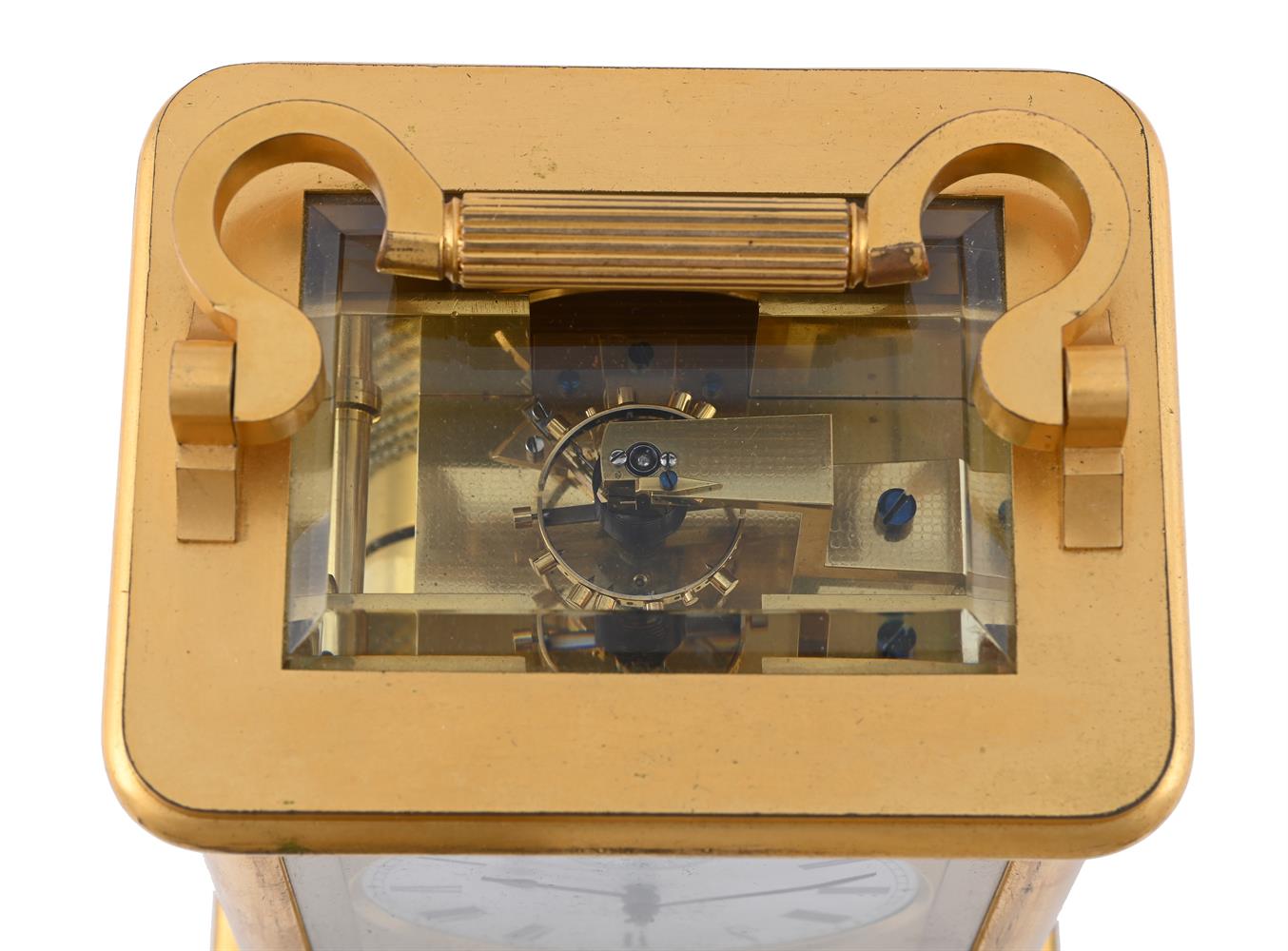A FINE VICTORIAN GILT BRASS GIANT CARRIAGE CLOCK WITH PUSH-BUTTON REPEAT CARTER, LONDON, CIRCA 1860 The eight-day five columnar pillar twin chain fusee train bell striking movement with Harrison's maintaining power and frosted gilt platform underslung lever escapement regulated by sprung split bimetallic balance with jewelled pivots to the going train, the backplate with central aperture revealing the balance regulation scale to upper margin over winding and hand-setting squares and engraved signature Carter, 61 Cornhill, LONDON to centre, the dial with fine foliate scroll pierced and engraved fretwork overlaid centre within 3.125 inch Roman numeral enamel chapter ring, with blued steel moon hands and set within conforming scroll pierced fret overlaid rectangular gilt mask incorporating shield cartouche signed CARTER, 61 CORNHILL beneath the chapter ring and framed by a canted bezel surround, the heavy thickly bevel-glazed frosted gilt brass case with hinged scroll-shaped handle over rectangular top glass, inverted ogee cornice, and rounded uprights to angles, the right hand side glass with push-repeat button and the rear with lift-out panel secured via a slide-latch and with shuttered winding and hand setting square holes, on cavetto moulded skirt base with rounded angles. 21.5cm (8.5ins) high with handle down, 15cm (6ins) wide, 12.5cm (5ins) deep. John Carter is recorded in Betts, Jonathan MARINE CHRONOMETERS AT GREENWICH as born in 1803 and apprenticed to Boys Err Burrill gaining his Freedom of the Clockmakers' Company in 1829. He is listed in directories as working from Tooley Street, London as a watch and chronometer maker with additional premises at 61 Cornhill from 1840. He submitted many chronometers for the trials at Greenwich coming first in 1834 with chronometer number 144, and again the following year with watch number 160. He also became involved with the City of London becoming an Alderman in 1851 and serving as Lord Mayor in 1859. He also served three times as Master of the Clockmakers' Company in 1856, 59 and 64. In 1873 John Carter took his son, John William, into partnership who then continued the business after John Carter's death in May 1878.
A FINE VICTORIAN GILT BRASS GIANT CARRIAGE CLOCK WITH PUSH-BUTTON REPEAT CARTER, LONDON, CIRCA 1860 The eight-day five columnar pillar twin chain fusee train bell striking movement with Harrison's maintaining power and frosted gilt platform underslung lever escapement regulated by sprung split bimetallic balance with jewelled pivots to the going train, the backplate with central aperture revealing the balance regulation scale to upper margin over winding and hand-setting squares and engraved signature Carter, 61 Cornhill, LONDON to centre, the dial with fine foliate scroll pierced and engraved fretwork overlaid centre within 3.125 inch Roman numeral enamel chapter ring, with blued steel moon hands and set within conforming scroll pierced fret overlaid rectangular gilt mask incorporating shield cartouche signed CARTER, 61 CORNHILL beneath the chapter ring and framed by a canted bezel surround, the heavy thickly bevel-glazed frosted gilt brass case with hinged scroll-shaped handle over rectangular top glass, inverted ogee cornice, and rounded uprights to angles, the right hand side glass with push-repeat button and the rear with lift-out panel secured via a slide-latch and with shuttered winding and hand setting square holes, on cavetto moulded skirt base with rounded angles. 21.5cm (8.5ins) high with handle down, 15cm (6ins) wide, 12.5cm (5ins) deep. John Carter is recorded in Betts, Jonathan MARINE CHRONOMETERS AT GREENWICH as born in 1803 and apprenticed to Boys Err Burrill gaining his Freedom of the Clockmakers' Company in 1829. He is listed in directories as working from Tooley Street, London as a watch and chronometer maker with additional premises at 61 Cornhill from 1840. He submitted many chronometers for the trials at Greenwich coming first in 1834 with chronometer number 144, and again the following year with watch number 160. He also became involved with the City of London becoming an Alderman in 1851 and serving as Lord Mayor in 1859. He also served three times as Master of the Clockmakers' Company in 1856, 59 and 64. In 1873 John Carter took his son, John William, into partnership who then continued the business after John Carter's death in May 1878.















Testen Sie LotSearch und seine Premium-Features 7 Tage - ohne Kosten!
Lassen Sie sich automatisch über neue Objekte in kommenden Auktionen benachrichtigen.
Suchauftrag anlegen